

Books
Cale is mentioned in a lot of books. Two biographies have been published, both with Cale's consent.
Read and destroy everything you read in the press
Read and destroy everything you read in books
It's a waste of time
It's a waste of energy
It's a waste of paper
And it's a waste of ink
Whatever you read in the books, leave it there
John Cale - Sabotage
Cale books

John Cale Songbook
Unofficial songbook with most of the transcribed lyrics, a couple of interviews plus a discography up to 1990.
Text in English and German.
500 numbered copies of this spiral bind bound book were made. A work of labour and love, tons of errors included.
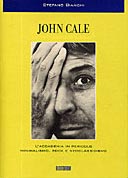
John Cale - L'accademia in Pericolo - Minimalismo, Rock e Neoclassicismo
Stefano Bianchi
Auditorium Edizioni, Italia, 1997
Paperback, 96 p.
ISBN 8886784066
Biography by an Italian journalist and Cale fan.
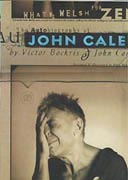
What's Welsh For Zen
The Autobiography of John Cale
John Cale & Victor Bockris
Designed and illustrated by Dave McKean
Bloomsbury Publishing, 1998/1999
ISBN 0 7475 3668 6
Must have for the serious Cale enthousiast. Lots of information about his childhood and early days in New York. The book is dedicated to Sterling Morrison:
"I thought it was the right thing to do, dedicating my book What's Welsh for Zen to Sterling. I think everyone discovers things after a person is gone. In my case, it happened while I was working on Some Friends. That realization caught me by surprise. I was writing Walking On Locusts. There was a string piece I'd written for Julian Schnabel's movie, the flattest piece of music I've ever made, no structure or profile. And I kept working it over and over again, and all of a sudden these lyrics started coming out. It was involuntary, but I realized quickly what they were about. It had this solitary effect, suddenly there was something in the back of your mind you weren't talking about but really felt. That was how Sterling's personality affected me. Much later."
Two different front covers. Also exists as a special autographed, hand-numbered edition (1000 copies) in a box: 272 loose-leaved pages and 12 pages in full colour. He sends a copy of both versions to Lou Reed:
"Dear Lou,
Out of respect for our past (both glorious and inglorious) I have sent you under separate cover both the special edition and the book version of my autobiography. Please accept them in the spirit in which they were offered . . . I also hope it brings you, at the very least, a distant smile of amusement. After all, it really was the most outrageous fun, wasn't it?"
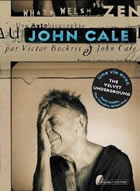
French translation
A French translation is published in 2011. Translator: Jean Cuesta.
What's Welsh for Zen? Une autobiographie de John Cale
Broché: 272 pages
Editeur: Au Diable Vauvert (13 mai 2011)
Collection: ALBUM
Langue: Français
ISBN-10: 2846262934
ISBN-13: 978-2846262934
Cale attends the presentation of the book at Librairie Atout Livres in Paris on May 30 for a Q&A and book signing.
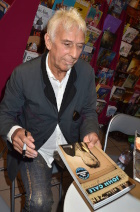
Musicien et auteur compositeur (fondateur avec Lou Reed du mythique groupe The Velvet Underground), producteur (Patti Smith, The Stooges, Siouxsie & the Banshees, etc.), le gallois John Cale a écrit avec le biographe Victor Bockris (déjà auteur de biographies sur The Velvet Underground, Andy Warhol, Keith Richards, Patti Smith et Muhammad Ali entre autres) son autobiographie “What's Welsh for Zen” (“C'est quoi le mot gallois pour zen ?”), illustrée par l’anglais Dave McKean (illustrateur de comics comme “Arkham Asylum” et “Cages”).
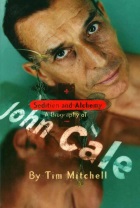
Sedition and Alchemy - A Biography of John Cale
Tim Mitchell
ISBN: 0 7206 11326
Limited edition:
ISBN: 0 7206 1207 1
Published in 2003. Written with the full cooperation of John Cale and incorporating exclusive interviews with important figures from all phases of the musician's 35-year career. From an account about a memorable show in London in 1975:
Cale had agonized long and hard about what form his first proper stage shows were going to take. Gone now were the projected theatrical extremes of the cancelled Victoria Palace show; in their place were the shades and the leathers and, at the Theatre Royal in London's Drury Lane on 11 May, a dummy dressed in a nurse's uniform. Inside the dummy's knickers was a capsule filled with fake blood. The idea was for Cale to attack the dummy at the end of the gig, but that all changed when during the course of the performance he broke a string on his guitar.
Also exists as a hardcover limited edition (500 copies). This includes a free CD contributed and signed by John Cale containing an exclusive, previously unheard and commercially unavailable song entitled Imitating Violins.

Also on the 1-track CD are Rick Myers' artwork images from the 5 Tracks EP and one of John Cale's self-penned paranormal bedtime stories accompanied by illustrations courtesy of Dave McKean.
French translation: Sédition et alchimie
A French translation by Serge Lefaure was published in 2005 by Camion Blanc:
Camion Blanc
France, March 2005
Paperback, 15 x 21 cm , 329 p.
ISBN: 2-910196-99-2
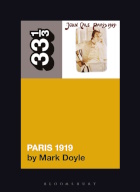
33 1/3 Paris 1919
Written by Mark Doyle
Continuum International Publishing Group, 2025
144 pages
ISBN-13: 9798765106792
As 2006 became 2007, somewhat to my surprise, I also began putting Paris 1919 on again and again. It became my default album, the one I'd play between other albums. The thing about most other music I liked during those years (think Silver Jews, Sufjan Stevens, New Pornographers, and TV on the Radio) was that, however great it was, it couldn't withstand constant repetition. You'd ruin it through overfamiliarity, like a joke told too often, so you had to dole it out slowly. But Paris 1919 never got old. I kept playing it and playing it, and it got stranger by the month.
It came to haunt me, this album-to haunt me and to mystify me. Even today, having played it a million times and sliced it frontways and backways and all other ways in order to write this book, I could listen to it again, right now, and find something new. I know other fans who feel the same way. This book is for them, but it is also for people who were like I was in 2006, impatient and slightly put off by the slick surface of the thing, confused as to how the guy who scraped his fingernails across the first two Velvet Underground albums could create something so warm and comfortable. Maybe, too, it is for the young John Cale himself, who began distancing himself from the album not long after it came out. In a 1974 interview, he called it "a bit too arty... a bit too much on the cultural side." The next album, he promised, would be better. "I don't want to make Procol Harum records."